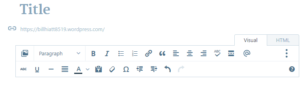Bill Hiatt's Blog, page 3
May 9, 2019
The Problems of Teaching Biblical Literature

(copyrighted by Rick Becker-Leckrone and licensed from www.shutterstock.com)
The Dilemma of Teaching the Bible as Literature
Influence of the Bible on Western Society
If you’re an English teacher, you probably already know most of what is mentioned here, but it’s possible some new teachers might not have given the issue much thought.
Actually, the issue doesn’t just relate to English teachers. Biblical literature (and religion in general) is pretty difficult to avoid in the teaching of history and the arts. Even though not every Westerner is a member of a Biblically-based religion, Western society has been influenced by the Bible in many ways.
I’m most familiar with the literary influences. The Bible underlies earlier English writers like Chaucer, Shakespeare, and Milton (the Big Three back when I was taking English classes at UCLA in the mid 1970s), and pretty much any other Western writer prior to the modern era. However, its influence is still visible in more contemporary works by Steinbeck, Faulkner, Hemingway, Golding, Atwood, O’Connor, and many others. Even contemporary bestsellers like J.K. Rowling and Stephen King make use of Biblical elements. ( see this article and this article ) for some interesting examples.

Michelangelo’s David (image copyrighted by PrakichTreetasayuth and licensed from www.shutterstock.com)
However, literature is only part of the picture. I was reminded of this frequently while I was teaching. For instance, some of my Jewish students who were taking AP Art History would complain about the endless (from their point of view) procession of Christian images they were studying. Even with the course’s recent inclusion of much more study of non-Western art, the enormous amount of religious imagery in the Western part is hard to miss. Music is just as much affected as the visual arts. I got a reminder of that every year as December neared. Someone almost always questioned the number of Christmas songs in the holiday music concert. The long-time vocal music teacher, who was Jewish–a cantor and the son of a prominent local rabbi–had to keep pointing out that the bulk of the most challenging seasonal music was Christian in origin. He didn’t mention the Bible specifically, but in fact the vast majority of the Christmas songs were explicitly Biblically based.
The Prevalence of Biblical Illiteracy
Prominent as the Biblical influence in our culture is, I was always surprised at how many students struggled with material that required knowledge of the Bible. I taught two classes that included some Biblical literature: Freshman Honors English, and World Literature and Composition. For most of my career, I taught at least one of those classes, and sometimes both, so I had a lot of opportunity to observe how little Biblical knowledge students brought to the class.

(copyrighted by Sabphoto and licensed from www.shutterstock.com)
For example, in Freshman Honors, we used an anthology that included Biblical texts and parallels in later literature. One of the sections features passages from Genesis and Mark Twain’s Adam’s Diary. You would be amazed at the number of students who couldn’t distinguish between the two. I still remember a student asking how Genesis could possibly have a reference to Niagra Falls in it. Eventually, we had to drop Zora Neale Hurston’s Moses, Man of the Mountain from summer reading because students couldn’t distinguish what Hurston said about Moses from what the Bible said about him.
Nor did the seniors in World Literature do any better. More than once, I got questions about why Santa Claus wasn’t in the Christmas story–from students who really weren’t kidding, much as I wish they were. The classic example, though, came from an essay written at the end of The Epic of Gilgamesh unit. One of the topics I used had to do with the differing attitudes toward heroism between ancient Sumerian society and our own. Many years ago, I received an essay on that topic that started this way: “Every society has its heroes. For example, Hinduism has Buddha, and Jewism has Jesus.” If one wanted to be nitpicky, that doesn’t directly misrepresent the Bible per se, but it’s hard to imagine that someone who can’t distinguish between Christianity and Judaism (or even name them correctly) has much Biblical knowledge.
Possible Controversy over Teaching the Bible
Since Western cultural literacy demands some knowledge of the Bible, and since most students seem to have very little of that knowledge, some study of the Bible as literature is essential. Public schools have the obligation not to advocate any particular religious philosophy, so in English classes, we’re obviously teaching the Bible as literature, not as a religious text. However, that distinction isn’t always easy to make, particularly with teenagers. Even some adults have difficulty figuring out what the difference really is. At best, handling the material requires a delicate balancing act on the part of the teacher, as I’ll explain below.

(copyrighted by cosma and licensed from www.shutterstock.com)
I worked in a high school in a relatively liberal community, so the curriculum was seldom challenged. In fact, I just glanced at a list of the eleven most commonly banned books ( found here ), and five of the eleven are or have been part of the curriculum in at least one course, all without protest. In the longer list of forty-six challenged books from the Radcliff Publishing Course Top 100 Novels of the Twentieth Century ( found here ), I counted twenty-two that are or have been part of the regular curriculum, as well as an additional eleven that are commonly on reading lists for book reports–again, all without challenge.
What one book did get challenged during my thirty-four years at the same school? The Bible. Generally, the reasons weren’t anti-religious. Parents objected not because they felt all religious literature should be banned, but because they were not Christian and had a problem with part of the New Testament being taught. However, atheists have from time to time mounted challenges against all religious literature, so you could encounter that as well. Students often objected too, but the motivation was more often avoiding something they feared might be boring. Typically, I’d start with several students objecting, but it didn’t take long to win them over.
Strategies To Teach the Bible as Literature without Having Issues
Explain what you are doing clearly, concisely, and early.
I always started a Biblical unit with an explanation of both why Biblical literacy was important and how teaching the Bible could be made consistent with constitutional requirements. (You may not get challenged directly on legality, but having worked in a district in which a large number of the parents were lawyers and a large number of students wanted to be, I found it useful to cover all the bases. It’s better to be prepared, just in case.)
The first handout focuses on the value of Biblical literature, the second on legal issues. I used both for years, so these are rather old and not especially good examples of graphic design. At the bottom of this post, you can download the Word originals if you want to rework them. That may also be useful for the legal one, which is California-centric. It would be better for you to provide case law and opinions relevant to your own state.
FH Use of Religious Literature
BIBLLIT
Make sure your own knowledge is as complete as possible.

(copyrighted by Stokkete and licensed from www.shutterstock.com)
Good preparation is important for teaching any subject, but it’s especially important in handling Biblical literature. Despite the fact that many students will be Biblically illiterate, some of them can and will ask relatively obscure questions. It’s not a problem if you can’t immediately answer a question. Offering to find the information or encouraging students to research it themselves and report back aren’t bad strategies. It is a problem, though, if you give inaccurate information. Knowing how adolescents are, you know someone will correct you later on. That will make students who are already nervous about the subject matter more nervous.
Manage discussion carefully.
Class discussion is an area in which studying the Bible as literature can really go off the rails in a big way. While students generally don’t start proselytizing for their own point of view, it’s not uncommon for some of them to declare whatever they believe to be the only possible interpretation.
Normally, of course, students getting excited about their opinion of literature is exactly what you want, and the more animated the discussion gets, the better. That atmosphere can be a problem for Biblical discussions, though.
The key, as in so many other situations, is balance. I never had a problem with student briefly stating their own religious beliefs as long as they prefaced them with “I believe” or some similar statement and do not imply that everyone should believe as they do. I also made it clear to students that they couldn’t ridicule a religious perspective different from their own or even argue with someone else’s.
To set the right tone, it’s important to lead by example. I wouldn’t normally hesitate to give my own interpretation of literature, but in Biblical discussions I typically respond to interpretive questions with, “Some people believe that…, other people believe this,” and so on. This is another point where knowing what you are talking about is important. You don’t want to misstate the view held by a particular religious group if you can help it. Ideally, every English teacher who taught the Bible as literature would be well versed in the study of comparative religions. No one can be knowledgeable about every possible variation, but it helps to know the major ones.

(copyrighted by Syda Productions and licensed from www.shutterstock.com)
Near of the beginning of the Biblical unit, I always talk about some of the major variations in the ways in which the Biblical text can be interpreted. It’s important to realize that some groups believe in full verbal divine inspiration–that is, that every word has been divinely inspired and is normally to be interpreted as literally as possible. Others believe that the Bible contains divine inspiration but that all parts may not be equally divinely inspired. Others (Universalists, for example) believe that the Bible and many other religious texts contain divinely inspired truths. Still others believe that the Bible is divine inspiration conveyed in ways that the original audience could understand; the general ideas are true, but the details, particularly with regard to science and history, may be concessions to what the original audience could understand and accept. Then there are those who see the Bible as divinely inspired but not literally true on factual matters. In this view, the stories are symbolic or allegorical, rather than literal. At the opposite end of the spectrum from full verbal divine inspiration would be people in non-Biblical religious traditions, who would regard the text as containing no inspiration at all.
You might expect some knowledge of the vast differences of opinion to be common knowledge, but that’s another area high school students have a problem with. To illustrate that point, I sometimes used a chart showing that even on such a simple question as what books were in the Bible, there were wide differences of opinion. As with the earlier documents, if you’d like to adapt this material, I’ve included the Word copy as a download at the end of this post.
(copyrighted by B Stefanov and licensed from www.shutterstock.com)
To see how a variety of interpretations would play out in practice, let’s look at the story of the serpent in the Garden of Eden, for example. Taking the text at face value, the serpent is a serpent, and the story is partly an explanation of why serpents have no legs, though that obviously isn’t its main point. Later interpreters, however, saw a variety of different truths in it. Christian commentators almost universally see the serpent as either symbolic of Satan or literally Satan. Medieval Kabbalistic Jewish commentators sometimes saw the serpent as Lilith (Adam’s first wife in the Talmud). Gnostics in early Christianity inverted the story by making the serpent the hero of the story, the one who brings knowledge to Adam and Eve that the creator (in Gnostic thinking an inferior being who was not the true God) had tried to keep from them. Roman Catholic thinkers saw the eating of the forbidden fruit that the serpent helped to engineer as the origin of original sin, but some of them also referred to it as felix culpa (fortunate fault) because it was a necessary step in the spiritual development of the human race. That’s just some of the more prominent beliefs associated with the story. One could write a book about it, and I’m sure people have.
I wouldn’t bring up every possible variation, of course, but I would try to make sure the students understood that there were different ways to look at the story. I would also try to ensure balance in the discussion. If one view seemed to be predominating, I would be sure to mention a different one. That way, a quiet student who didn’t necessarily agree with the majority would still feel safe in believing something else.
That’s really the heart of a good discussion on the Bible as literature. Everyone can voice his or her view–or not voice it. Either way, the classroom is a safe space to hold that view. If you create that kind of atmosphere, you should have minimal problems with the unit.
Word Downloads
(If you just want the PDF format, you can download that directly from the viewer windows above.)
Legal Issues
Download Now!
Value
Download Now!
Contents
Download Now!
(A form of this article was published on October 31, 2017.)
The Problems of Teaching Greek Mythology

Sanctuary of Athena at Delphi (licensed from www.shutterstock.com and copyrighted by peterlazzarino)
Why Is It Important to teach Greek Mythology?
This section is primarily for those of you who aren’t English teachers, though there is some difference of opinion on this subject, even among English teachers.
I’m a big believer in avoiding what Will Herberg referred to as a “cut flower culture.” That’s true, not just in the spiritual sense in which Herberg meant it. It’s also true in the sense of general knowledge. If we don’t understand the roots of our culture, we don’t really understand our culture.
In Western civilizations, the Bible is the most influential literature hands-down. I’ll talk more about that in a subsequent blog post, but I will mention quickly that I don’t intend that as a religious statement. One can have the cultural literacy that the Bible provides without being an adherent of a Biblically based religion. (As I used to say to my students, you can read Moby Dick without having to believe that there was a great white whale that matched the title beast’s description.)

It’s hard to miss the classical columns and other touches in early American public architecture. You can see the classical influence on the University of Virginia rotunda, designed by Thomas Jefferson. (Joseph Sohm/Shutterstock.com)
Though the Bible in indisputably the single most influential body of literature in the West, Graeco-Roman literature is just as securely number two. Our own literature, film visual arts, music, law, philosophy, and even architecture are all indebted to the Greeks and Romans.
From the moment that the United States declared its independence, it tried to establish its own cultural identity. While not rejecting its English heritage, it turned to Greece and Rome, sometimes directly and sometimes indirectly, for political inspiration. Democracy comes originally from a Greek word, just as republic comes from a Latin one and evokes the Roman Republic. We also borrowed Senate from the Romans, among other things.
Shakespeare is a good example of a writer strongly influenced by the Graeco-Roman heritage. Two of his favorite works were Ovid’s Metamorphoses and Plutarch’s Lives. (If you’re interested in details, Jonathan Bate’s Soul of the Age: a Biography of the Mind of William Shakespeare provides a very thorough treatment of Shakespeare’s use of the classical heritage. I can’t at the moment find any commentaries more narrowly focused on sources that aren’t very expensive.) The story of Pyramus and Thisbe crops up twice in his work, once as the distant ancestor of the plot of Romeo and Juliet, and once directly, in Midsummer Night’s Dream. His Roman history plays are naturally based on Plutarch. His longer poems, Venus and Adonis and The Rape of Lucrece , are similarly classically inspired. Some of his early comedies seem based on Roman models. His tragedies, much like those of his contemporaries, owe something to the tragedies of Seneca. Even in plays like The Tempest, that are less obviously connected, still show Graeco-Roman touches. For instance, Bate notes the similarities between the way Prospero’s magic is described and the way Medea’s dark arts are portrayed in Ovid.
Nor is Shakespeare the only author inspired by the Graeco-Roman tradition. Even a very partial list seems overwhelming: Chaucer, Dante, Ariosto, Milton, Shelley, Keats, Tennyson, Pope, Shaw, Joyce, Hawthorne, T.S. Eliot, Eugene O’Neill, Thornton Wilder, John Updike, and too many others to list here. I should mention that the influence continues even today. Consider Rick Riordan’s Percy Jackson books, for example.
My more pragmatic students used to say, “So what?” The specific answer in an English classroom would be that it’s hard to understand classically inspired literature without some knowledge of that heritage. The same thing is true in college. A survey by the Society of Biblical Literature, which naturally focused on the importance of biblical literacy, did ask one question about Greek and Roman literature, and the professors surveyed agreed that knowledge of Greek and Roman mythology gave students a clear academic advantage. Since students typically need to take at least a few English classes to satisfy breadth requirements, even the most narrowly grade-oriented students would have to agree that a certain amount of classical knowledge would be helpful in college.
Unfortunately, teaching Greek and Roman literature, mythology in particular, does raise some problems.

Pediment at Academy of Athens (copyrighted by Anastasios71 and licensed from www.shutterstock.com)
What Are the Problems of Teaching Greek Mythology?
First, despite how much the ancient Greeks and Romans contributed to our own society, the cultural gap between the two sometimes seems overwhelming. As with most ancient societies, women were generally considered a form of property, slavery was accepted without question, violence was a much more popular solution to problems–and the list goes on. It’s hard not to be offended or disturbed by at least some of it. On the other hand, denaturing it too far to make it more palatable to contemporary high school students takes away some of its educational value. Also, students need to be able to understand other cultures, even when they don’t agree with the values of those cultures. Finding the right balance is tough, though.
Second, because the mythology comes to us through the writings of dozens of authors over a span of centuries, the stories are often inconsistent. One can often find contradictions even within the same author’s work. (Hesiod describes Cronus as imprisoned in Tartarus in one work but says that he is ruling Elysium in another.) It is this incoherence that frustrates students who can lead the hurdle of cultural difference to appreciate science fiction and fantasy. That’s because a modern novel, TV show or movie in one of those genres will have a consistency mythology lacks.

(copyrighted by sabphoto and licensed from www.shutterstock.com)
Real people and believable literary characters act somewhat predictably. If their attitudes and actions change, they do so ways that seem motivated by changing circumstances. In the case of literary characters, that’s why readers can relate to them. That’s also why it’s hard for teenagers to relate to characters who don’t stay consistent from story to story. Is Heracles a great hero, a well-meaning oaf, or a murdering sociopath? Is Aphrodite the gentle patroness of love who takes pity on Pygmalion by bringing the statue he has fallen in love with to life, the harsh punisher who gets Hippolytus falsely accused of rape so that his own father will kill him, or the nightmare prospective mother-in-law in the Cupid and Psyche story? Is Lycomedes the paranoid who murders Theseus on the off-chance that the hero might one day take his throne or the easily duped father who somehow accepts Achilles having sex with one of his daughters after being given sanctuary in his home? Sometimes logical reasons can be found for these apparent contradictions, but often they can’t be reconciled. They simply are. Sure, some of the variants can be tossed out, but too much sculpting of the material will remove some of its value in the same way that too much cultural adaptation will. Again, it’s tough to find a good balance.
During the several years that I taught a freshman honors English class in which mythology was an important component, I spent quite a bit of time searching for a good mythology book. At the time, we were using Edith Hamilton’s Mythology. It’s unquestionably a classic, and adult mythology enthusiasts still love it, but it was never intended for teenagers, and a lot of contemporary teenagers have trouble with it.
Replacing it, however, was easier said than done. I searched for years, and the books I could find fell into three categories. First were the adaptation intended for children. As a young child, I loved D’Aulaires Book of Greek Myths, and I’d still recommend it to someone looking for a book for young readers, but it’s a little too young for high school.

(copyrighted by Sabphoto and licensed from www.shutterstock.com)
The second group were the works intended for scholarly use, such as The Routledge Handbook of Greek Mythology and the more literary but still scholarly Greek Myths by Robert Graves. Both are too long and too complex for high school and are not well-adapted to a teenage audience, though either would be great for comprehensive adult study.
The third group are books for the general reader that primarily address one myth or connected group of myths. Any of those might work for high school, but none of them has a wide enough range to cover even the same ground that Edith Hamilton does.
I even offered my students extra credit to anyone who could find a mythology book that met my criteria. No one ever could, though.
After I retired, I learned that the teachers who followed me in freshman honors were having the same problems with mythology I had experienced. I still hadn’t found a workable alternative, so, in collaboration with my former colleagues, I decided on a radical experiment: I would write my own mythology book.
Shameless Plug for My Book

(copyrighted by Slava Gerj and licensed from www.shutterstock.com)
My book, A Dream Come True: An Entertaining Way for Students To Learn Greek Mythology, adopts a different approach than a typical mythology text, in part because of its hybrid nature. The myths are wrapped in a young adult urban fantasy frame story. The basic premise is that some high school students cramming for a mythology fall asleep, and when they wake up, they find themselves in the world of Greek mythology. At first, they have no idea how to get back to the real world. Even worse, one of them gets on Hera’s bad side, ends up becoming a dog and then vanishing before Hera can undo what she has done. Complicating matters still further is that the remaining students unwittingly become entangled in a plot by god or gods unknown to disrupt the order of Olympus.
They cling to the idea that they are just dreaming–but what about the old superstition that if you die in a dream, you die in real life? And what happens if they can’t find their missing friend? Saving him and escaping require them to unravel the mystery of who the secret rebel among the gods really is. In the process of looking for clues, the students have to travel throughout ancient Greece (both real and mythical) and examine each myth (often told by one or more of the characters in the myth).
What benefits does this approach provide?

(copyrighted by Slava Gerj and licensed from www.shutterstock.com)
High school students seem to react better to the novel format than a series of short tales. They’re just more used to it. It’s also worth noting that the frame story itself is an ancient technique, the oldest surviving example of which is Ovid’s Metamorphoses.
By having the student characters raise the same questions that students used to have in class, the book addresses potential points of confusion as they arise. It also enables the student characters to frame the stories in terms of modern values. Thus, though individual stories may not agree with a reader’s moral sense, the book as a whole provides more comfortable and familiar messages without whitewashing the original material. It also offers opportunities for philosophical discussion and debate among the characters. That leaves room to show some differences–ancient Greek society was not monolithic. It also leaves room for modern differences of opinion. Every single issue raised by the myths is not one we’d all answer in the same way, and I didn’t want the book to be overly preachy or to push too hard in one direction on controversial issues. At the same time, it does provide some opportunities to include character education in the study of mythology.
Fleshing out the mythological characters as if they were real people, in particular providing them with consistent personas, makes it easier for students to relate to them. How did I do that without denaturing the material? Naturally, I had to pick a version of each story, and usually I picked the ones that could most easily fit together. However, I preserved major variations by having the characters discuss them as rumors or as deliberate propaganda by their enemies. By the way, there’s a good argument, made by Graves among others, that some of the stories were intended as political propaganda originally. For example, the more savage stories about Heracles may come from the time after the Dorian invasion. At that point the other Greek peoples had every reason to try to discredit Heracles because the Dorian leaders claimed descent from him. It’s easy to see in other cases how one Greek city would try to build up its own hero while a rival city might try to tear him down. The same thing may be true of the gods, whose major centers of worship were often in conflict with each other.
The presence of the student characters makes it easier to make the text interdisciplinary. I’ve already mentioned character education, but you’ll also find bits of history, psychology, art and architecture as well.
[image error]
(copyrighted by Sabphoto and licensed from www.shutterstock.com)
I think the book strikes the right balance between preserving the integrity of the original material and adapting it to a modern high school audience. Whenever possible, I resolved conflicts (and potentially inappropriate material) using an approach found in the works of at least one ancient writer. Points where I had to go beyond the literature are clearly identified, often in the text itself, always in an appendix.
Speaking of appendices, there are several. They are intended to meet the needs of different students. Some will need help sorting out the complicated family relationships, and for them I provided a wealth of genealogies. Some will be content with the text alone, but others may want further resources, and for them I provided an extensive annotated list. I also provided the ancient sources for the material in each chapter. (Students need plenty of reinforcement in citing sources, but extensive in-text source citations are distracting to some high school readers.) For the benefit of teachers who want to be sure students also know the Roman names, I’ve included an appendix for those as well.
Results of the Book’s First Use
The two teachers using the book in their freshman honors English classes both reported higher levels of engagement and better test results than with the book they had been using previously. I came in as a guest speaker when they were prepping for the test and noticed more enthusiasm for the subject matter than I had seen when I taught the class. That’s not to say that every single student was thrilled by the book, but it does seem to work better than some alternatives.
Handy Book Preview If You Want to Find Out More:
Information for Schools Considering Adoption:
I’m happy to answer any questions you may have. Please feel free to email me at the address in the header for further information.
I intended this book to be a service rather than a moneymaker. (Given its hybrid nature, it’s not destined to be a bestseller.) 
Teacher Stress Management

(copyrighted by KieferPix and licensed from Shutterstock)
One of the most surprising things about teaching I discovered when I first started in the profession was how much stress a teaching job generates. Nowadays I think teacher training programs incorporate more material about that, but even with some preparation, it’s difficult to really understand the levels of stress involved until one actually teaches.
The second surprise is that students are often not the primary cause of teacher stress. Sure, we’ve all had the mischievous soul who tried our patience or the student in trouble who tugged our heart strings a little too hard, but in my experience much more stress can come from outside factors such as inadequate funding or excessive politicization, as well as adults in the system who somehow find ways to make your life more difficult.
Why should you be concerned about stress? Because too much stress reduces the effectiveness of your teaching. I won’t repeat all the evidence for that here, since it is amply documented elsewhere, but if you are interested in specifics, you might want to look at articles like this (though it focuses more on depression, one of the possible consequences of stress), this, and this.
Searching the links above reminded me what part of the problem is. Even with searches carefully tailored to elicit results about teacher stress, most of the top hits were articles about student stress. Don’t get me wrong–student stress is also very important. However, a lot of analyses have a tendency to forget that teachers are people, too, and that their psychological state can also be important.
Not only is stress destructive in the classroom, but it’s toxic to your health as well. You can find a good summary of those issues here. I didn’t really become aware of the variety and seriousness of the problems until my former school district stated having trouble with insurance providers. They frequently cited stress-related health problems as a reason to charge more for group insurance, and that naturally got me thinking about the subject.
In the interest of full disclosure, I never succeeded in mastering my stress; it’s why I retired early. I apparently got out just in time, too. I was starting to develop some very obvious stress-related symptoms, like having chronic low-level headaches that stopped every summer.
That said, my experience with handling stress and seeing how other people handled it might be useful to you, so I have provided some tips below.
Organize yourself well. That was always hard for me, but I definitely felt less stress when I had more control. In practice that meant not having to hunt for things, not getting two meeting scheduled at the same time, that kind of thing. The time organization takes is more than made up for by the time–and frustration–you save down the line.
Set manageable goals each day, and, except in unforeseen circumstances, meet those goals. I don’t know why, but I used to go into a day sometimes thinking I would get far more grading done than I did. When I failed to meet my goal–which happened often with overly ambitious grading goals–I ended up feeling more stress. I’ve seen students fall into the same pattern, and in either case the result is likely to be a downward spiral, since rising stress levels will make it harder to meet the next goal down the line.
Make time for relaxation and enjoyment. Some of you, particularly English teachers or others in high-paperload disciplines will laugh about this one, but it’s true. You cannot work all the time without running the risk of overly high stress levels, and eventually, burnout. Part of having a good organization is making time in your plan for pleasurable activities.

(copyrighted by Monkey Business Images and licensed from Shutterstock)
Make time for family and friends. Don’t forget about the people in your life, no matter how much work you have. It’s easy to lose track of old friends and even create tensions within the family by not keeping in touch. When I first started teaching high school, I couldn’t help noticing how many of my colleagues in the English department were either divorced or unmarried. In fact, one of the standard jokes among the younger teachers was that the official card game of the English department was Old Maid. Ironically, I ended up unmarried as well, and over time my friends outside of school faded away. You may think this is an avoidable problem, and it is, but it is also very easy to keep putting off the people in your life until a more convenient time–which sometimes takes weeks to arrive.
Take advantage of every little opportunity for exercise. Unless you teach physical education, there may not be much built-in exercise in your job, and though teaching itself isn’t that sedentary, grading and planning both are. Even if you don’t have time for a regular workout at the gym, you can still increase the exercise you get–and lower your stress in the process–by finding ways to insert short bursts of exercise into your daily routine. For example, I worked in a multistory building and always took the stairs instead of the elevator. When I could run errands on foot rather than by car, I did that (which also saved me the stress of traffic and finding a parking place). Some schools will help by organizing teachers for before and/or after school fitness walks or something similar. Make use of any opportunity like that if it fits your schedule.
Realize that you can’t do everything. One of the biggest stress creators in teaching is the fact that it is in many ways a bottomless-pit job. No matter how much you’re doing, you can always be doing more. Because of that, it’s easy for teachers to overwork themselves, as well as to be overworked by the system. Realizing one’s limits is hard; I got there only near the end of my career. Hopefully, you’ll be better. The key is figuring out how much you can reasonably do for your students, and, except in cases of dire emergency, resist the urge to keep escalating. For instance, if you’re an English teacher, you have to learn not to give massive amounts of feedback on each essay. Perhaps a few key assignments will need that much. Others can get less, or get feedback focused only on one aspect. Others may get a check-off rubric rather than comments. If you train your students well enough, peer feedback can also supplement the feedback you give. If a student is really struggling, you can also vary the amount of feedback you give on each assignment based on student need–but in that case, monitor yourself carefully to make sure your feedback is not creeping beyond a manageable level.
(copyrighted by PKpix and licensed from Shutterstock)
Yes, all of these suggestions are common sense. Unfortunately, it’s all too easy to lose track of common sense in the maelstrom that is teaching.
(A form of this article was published on October 30, 2016.)
What’s the Purpose of Education?

(copyrighted by Monkey Business Images and licensed from www.shutterstock.com)
“The function of education is to teach one to think intensively and to think critically. But education which stops with efficiency may prove the greatest menace to society. The most dangerous criminal may be the man gifted with reason but no morals.…We must remember that intelligence is not enough. Intelligence plus character—that is the goal of true education.”
Martin Luther King, Jr., Morehouse College speech, 1948
One crucial step in creating the best possible education system is figuring out what you want that system to accomplish. While establishing goals sounds as if it should be simple, the process isn’t as easy as one might think.

(copyrighted by digidreamgrafix and licensed from www.shutterstock.com)
A recent Phi Beta Kappa poll illustrates the problem: 45% of people surveyed said the primary purpose of the school system should be to prepare students academically, 26% said it should be to prepare students to be good citizens, and 25% said it should be to prepare students for work. The US News and World Report article on the poll describes the current state of the issue as “confusion.” Indeed, if we can all agree on one thing, it’s that people find defining the purpose of education confusing.
In part these poll results may suggest a reaction against the one-size-for-all college-for-everyone ideal that schools (and education reformers) have embraced in recent decades. My former school district, which has always had graduates go on to college at a rate above 90%, a few years ago eliminated all courses that weren’t “college prep,” (by which school board members really meant UC certified–all courses had been designed with college in mind).

(copyrighted by Elnur and licensed from www.shutterstock.com)
As much as a rigid tracking system (in which at some point students are locked into a particular path from which they have a hard time escaping) is bad, it’s interesting that people often miss the fact that the kind of system my former district adopted is essentially a rigid tracking system with only one track: college. While we all agree that every student should have the opportunity to go to college, is it really true that is the best choice for every single one of them, without exception? For example, if a student really wants to be an auto mechanic, is there a reason to force four years of college–and a load of student debt–on him or her?

(image copyrighted by goodluz and licensed from www.shutterstock.com)
It isn’t just students who are involved in “hands-on” professions like auto repair who might not always be a good fit for college. That’s the theory behind Peter Thiel’s idea of paying students to develop their own business ideas rather than go to college. One of my former students set up his own resale business that grossed $30,000 a year while he was still in high school. He went to college to get a business degree, but I could see someone wanting to spend those four years growing a business that was already successful. I’ve also known students who had flourishing acting careers when they were still in high school. Several ending up getting their diplomas through the high school equivalency exam. Some of those did end up getting college degrees, usually in a nontraditional way, but it would be hard to argue, unless they went to a performing arts school, that a college degree had much to do with their actual careers.

(copyrighted by kwest and licensed from www.shutterstock.com)
I should mention that, among the courses eliminated by my former district were all those offerings geared to students reading two or more grade levels below the norm. Students in that situation could get into community college but probably wouldn’t have the grades to get into a four-year school immediately after high school. Could a student like that improve his or her reading level enough to perform decently in college? The research I’ve seen suggests the answer is yes–if he or she had the very kind of support structure the board cut away in its zeal for UC certified courses. Yes, you’re reading that correctly: in order to push every student to college, the district removed the very structure the weakest students would have needed to have a shot at making that goal.

(copyrighted by Dennis Kuvaev and licensed from www.shutterstock.com)
By the way, even with the right kind of support, such a student would probably not improve more than 1.5 years in reading level for every year in school. If you do the math, that means someone coming into 9th grade reading at the 6th grade level would catch up with his or her peers at the earliest by sophomore year in college. That kind of situation might be another reason for a student to attend a community college, which often provide remedial programs for students with skill deficits.
Not only did the district never quite grasp this reality, but it also tended to sneer at community college as a possible option. Board discussions often made it seem as if community college really wasn’t college at all, often cited college attendance statistics that counted only graduates who went to four-year schools, and otherwise disparaged any suggestion that community colleges were worth anyone’s time–an especially odd position considering the number of career paths that require only an associate’s degree for entry. Rather than accept the fact that some students’ performance in high school might make community college the best next step, the district told counselors to make lists of four-year schools that would take students with B averages and C averages. (I didn’t stay long enough to see the inevitable D average list, but I’m pretty sure the South Harmon Institute of Technology would have been at the top of it.) There was even talk of making applying to a four-year school a graduation requirement, though in that case the total unenforceability of that idea defeated it.

(copyrighted by pelfophoto and licensed from www.shutterstock.com)
If you’ve been around long enough, you realize that when the pendulum swings too far in one direction, it tends to swing back too far in the other direction. The inevitable reaction of trying to shove everyone into college, regardless of circumstances, naturally bred pressure in the other direction. The mounting college debt crisis didn’t help the situation, either. Peter Thiel was not alone in trying to promote noncollege pathways.
Despite what I wrote earlier, too much of a pendulum swing in that direction would be a profound mistake.

(copyrighted by llike and licensed from www.shutterstock.com)
While I don’t believe that every single student’s first-best destiny involves college, I do believe in choices. Students should be prepared for college, even if that sometimes means having the support of more basic classes they might need to get them to the right level, and even if a few of them ultimately decide on a different path. To do otherwise would be foolhardy. Though we can cite individual exceptions, a Pew Research report in 2014 confirms that college graduates make far more than their high school graduate peers–and that gap is widening. The same report confirms that the college graduates are considerably less likely to be unemployed or to be living in poverty, as well as more likely to be satisfied with their jobs and confident in their ability to advance further in their chosen career.
Nor should the short-term employment picture be our only consideration. Yes, some people are successful without college, and some people earn degrees that don’t lead to a career in any logical way. Again, however, those are exceptional cases–and training narrowly for one job doesn’t do justice to the rapidly changing realities of the job market. The Hechinger Report points out that a well-designed college education can develop general critical thinking and creativity that may help prepare students for jobs of the future that don’t even exist yet, among other things.

(image copyrighted by Lightspring and licensed from www.shutterstock.com)
You’ll notice that the poll results with which the article started present us with a false trichotomy, at least to some extent. The implied split between academic preparation and job preparation isn’t as sharp a divide as one might at first assume, except for people for whom vocational school might arguably be a better option. Even students whose college major doesn’t directly prepare for a career may be preparing for work–and life–in ways that may not be immediately apparent. Yes, we should make sure that vocational pathways are available, as Katherine Martinko has argued, but that can be done in the context of a high school model that embraces preparing students to make choices rather than pushes them in only one direction. (The student who wants to be a mechanic today may change his mind tomorrow and needs to have the skills to shift paths if he or she wants. In any case, the way we are going will probably require mechanics to also have considerable computer skills before very much longer.)

(copyrighted by Rawpixel and licensed from www.shutterstock.com)
What about citizenship preparation? It is possible to integrate that with academic and career preparation in a way that does justice to all three. English, of course, lends itself to just such a synthesis, since literary analysis flows naturally into discussion of the moral and philosophical issues raised in the literature, but English is certainly not the only discipline that does that. History teaches citizenship through the mistakes and triumphs of the past, government by making sure everyone was a working knowledge of the political process, and virtually every discipline contributes in some way, because an effective voter is a well-informed voter. (Unlike Donald Trump, I don’t love poorly educated voters!) For example, someone with a working knowledge of biology is better able to understand the moral and practical implications of genetic research. Someone with a working knowledge of economics is in a much better position to evaluate the merits of different financial proposals.
Yes, my perspective is idealistic. In an era of diminishing school resources, it’s hard for the schools to do justice to everything with which they are asked to cope. However, if we decide that developing the intellect, the career and the citizenship are all equally important, we can make it happen. Prioritizing goals that all have such great importance is not an option.

(copyrighted by Marvent and licensed from www.shutterstock.com)
Tips for Students Who Want To Start a New School Year Right

(copyrighted by RyFlip and licensed from www.shutterstock.com)
(This article is written with high school students in mind, though in some cases the advice might also work for younger students.)
When it’s that time of year again, hopefully you’ll look forward to with joy–but realistically you may end up missing the summer, at least for awhile. If you’re reading this article, you probably know that school, whether you view it as a thrill or a chore, is important to you. Making the most of education now can make life a lot more rewarding in the future. With that in mind, I’ve compiled some suggestions for how to make the most of that opportunity.
Make a good impression on your teachers.
You know the old saying, “You never have a second chance to make a first impression”? There is a lot of truth to it. I’m not suggesting that you should adopt a “teacher’s pet” mentality. I am suggesting that common courtesy goes a long way in human relationships in general, and student-teacher relationships are no exception. Since it is possible to be polite without being a “kiss-up,” make every effort to treat your teachers well. Remember that teachers are people too. (I know it sounds silly to say that. Of course you know teachers are people, but I’ve found that high school students don’t always embrace that truth emotionally. Early in my teaching career, I ran into some some students at the UCLA Mardi Gras, and one of them said, “Mr. Hiatt, what are you doing here?” I replied, “Probably the same thing you are,” and they all looked stunned, as if they were thinking, “You mean you don’t crawl into the filing cabinet at the end of the school day and go into suspended animation until school starts again?” I would have thought of this experience as a one-off kind of thing, except that it happened a lot.)

(copyrighted by s-ts and licensed from www.shutterstock.com)
Aside from being polite to the teacher, if you have negative feelings about the subject matter, try to keep those to yourself. Strange as it may seem, teachers would like to think that, even if everyone isn’t thrilled by the subjects they teach, everyone understands that those subjects are important. Teachers know that not everyone is going to be naturally brilliant in their subject and that levels of enthusiasm will vary, but, especially early in the year, it’s best to avoid questions like, “When will we ever use this in real life?”
It is also wise to avoid rookie mistakes. These include sitting as far back in the room as you can (which suggests that you are trying to hide–and therefore that you will probably want to get away with something), showing negative feelings toward other students (since teachers don’t like bullies and might misinterpret your intent), and being overly informal with the teacher (since teachers, though they should be friendly, can’t actually be your friends). That last point seems paradoxical to some students, but if you think about it, you’ll realize it’s true. That said, teachers do accept varying levels of formality. As the year progresses, you’ll get a more specific feeling of what is and is not appropriate in each classroom. At the beginning of the year, it’s best to be relatively formal. You can always loosen up later, if the teacher’s style allows for it.
(Special Note for Juniors)
If you are planning on applying to colleges that require teacher recommendations, then you may already know that your junior teachers (particularly the ones in academic subjects) will probably be the ones from whom you need to select recommenders.
As with any other kind of sales pitch, recommendations are much easier to write when the teacher is advocating for a student about which he or she is enthusiastic. It’s in your best interest not only to make a good first impression, but to maintain that first impression throughout the year. I’m not suggesting that you be phony to do that, but I am suggesting that, as the University of California system recommended to students writing college application essays, “Be yourself, but be your best self.”
Take it from someone who’s written recommendations for over a thousand students during my teaching career. If you create the best record you can, a teacher will have no difficulty writing for you, even if you aren’t the world’s most brilliant student. If you do less than your best, a teacher will generally know it, and, while he or she won’t make overt negative statements about you, college admissions people reading those letters are good at spotting situations in which the teacher is faking it rather than being genuinely enthusiastic.
Be as active a participant as you can.

(copyrighted by michaeljung and licensed from www.shutterstock.com)
All things being equal, actively engaged students learn more than passive ones. Not only that, but, to return to my last point for just a minute, a teacher is more likely to know an active student better than a passive one. Remember that recommendation writers have to comment on your personal qualities as well as your academic achievements–and I can tell you from experience a teacher isn’t going to have a clear picture of a student’s personality if the teacher has never even heard the person’s voice.
Some of you may be cringing at this point if you’re shy. You don’t have to become Mr. or Ms. Assertive overnight. Remember that teachers also value improvement. If you have weak spots but are trying to improve, a teacher will understand that and appreciate your effort.
What that means in practical terms is that you should try to participate a little bit at first and gradually work yourself up to more. The students I’ve known who made the attempt were always happy they had. The students who didn’t were just postponing the inevitable in some cases. The reality is that a lot of professions involve a certain amount of verbal interaction, so if you want to go into some of those fields, you will have to take the plunge sooner or later.
By the way, if you’re prepping for an oral presentation and want some pointers, you can find the video version of my PowerPoint on the subject here.

(copyrighted by Rawpixel.com and licensed from www.shutterstock.com)
Get organized–and stay that way.
If you have a typical load, you probably have five or six classes, and some of you may have more. That’s going to be a lot of instructions, handouts, and deadlines coming at you, so good organization is essential.
Some schools have partially automated the process in one or more ways: assignment calendars posted online, email assignment reminders, and other similar devices. However, many have not, so you need some way, whether digital or nondigital, for keeping track. If a school or teacher doesn’t limit your options (for example, by banning digital devices in the classroom), find a system that work well for you. If you are constrained by rules from using the system you like best, find the best way to work within the structure you have.
Ask questions–unless you can answer them yourself.

(copyrighted by Lorraine Swanson and licensed from www.shutterstock.com)
Asking questions is an important part of learning, and no good teacher is ever going to be annoyed by a legitimate question. That said, teachers can be annoyed–and you can end up wasting their time and yours–by asking a question for which you could very easily have figured out the answer yourself.
The classic example of this kind of problem is the student who has been given written directions and asks a question that could easily have been answered just by reading those directions. Chances are you’ll never again get as many written directions as you do in high school, so why not take advantage of them? Always read the directions first. Then ask the question if you still need to.
The same advice also applies to oral directions. Listen to what the teacher is saying, and then ask if you still need to.
It also pays to listen to the questions other people ask–and the answers they get. I can’t tell you how many times I got asked the same question I’d already answered in the same class session. No one is perfect, of course, so you may miss an earlier questions occasionally, but doing it often suggests you aren’t paying attention–and that creates a whole new set of problems.

(copyrighted by Monkey Business images and licensed from www.shutterstock.com)
Take notes.
Every year I was amazed by the number of students not taking notes or taking notes so vague that they would have been useless for review.
In the thirty-four years I taught, I encountered very few students with such good memories that they could perform as well without taking notes as they could with notes. My own experiment in two senior classes showed that note-taking students performed 19% better than non-note-takers in one class and over 25% better than non-notetakers in the other one. These results are not surprising, since studies have shown anything from a 13% gain to a 44% gain from note-taking. With that kind of evidence, it’s surprising everyone doesn’t take notes by choice. Sadly, many of my students had to be forced, and then they often did the bare minimum.
How you take notes is largely a matter of personal preference, unless your teacher mandates a particular style. My personal preference for some time has been digital notes (easier to search and organize, less likely to be lost). There is a lot of research suggesting that digital notes are not as effective, however. One of those studies is reported here. Looking at the reasons digital note-taking is less effective, though, I think their impact could be reduced or eliminated. Basically, the students in the studies that looked at this issue either wrote too much (and therefore stopped listening as well) or became distracted by the digital environment in one way or another. Oddly enough, in several years of encouraging students to take notes digitally, I never saw a student doing the transcript style note-taking criticized in the study. In any case, it seems to me that a person could train himself or herself not to write too much down. The digital distraction issue is a more serious one, and it often causes both high school teachers and college professors to ban laptops, tablets, and cell phones in their classes. I always felt that students needed to learn how to overcome those distractions, but I’ll admit it wasn’t an easy thing for some students to do. If you are in an environment in which digital note-taking is permissible, you’ll need to train yourself to avoid the temptations that format presents.
Even if you take physical notes, you still need to adopt a reasonable strategy in order for them to be effective. That means you need to practice identifying the material that is the most important (and/or that you’re the most likely to forget). You also need to write it down in a way that captures enough to remind you of what you heard, but not so much that you get bogged down in the physical process.
If you haven’t thought much about note-taking at all, you might like this summary of different methods. That doesn’t mean you can’t develop your own system, as some of you probably have. Just make sure it works for you.
Below is the notetaking handout I used to distribute to students. It provides a fuller explanation and might prove useful to some of you. If you need help with the viewer controls, there are some tips here. (The viewer seems to be having some trouble with Chrome at the moment, so just in case, I’ve also included a download button.
Class Notes 2014
If you have control over the membership of a work group, think carefully.

Group? Yes. Work? Doubtful! (copyrighted by Belushi and licensed from www.shutterstock.com)
Most of you have probably had some experience with group work, since it plays a role in a number of different instructional strategies. More often than not, the teacher will select the group membership, but if you are given some discretion, make good use of it.
The first problem I’ve noticed in student-selected groups is the tendency for people to group with their friends. This kind of arrangement naturally leads to a variety of temptations you would ideally want to avoid–at least if you actually want to get work done.
Even in situations in which friends in a group managed to avoid too much socializing, I sometimes found the group didn’t work as well as it should because the students shared common weaknesses. For example, it doesn’t make sense if you’re shy to group with all of your shy friends to plan an oral presentation.
The ideal group is one in which everyone gets along, but either is not composed of friends or includes only friends who can resist temptation. In addition, every skill required by the task is covered by at least one student. The ideal group also has one person who is accepted as leader (organizer) and who has the skills to keep the group on task. If the group has to do some work outside of class, it’s also important that the members have compatible schedules (a variable I noticed students often forgot to check).
Understand the basics of plagiarism.

(copyrighted by Jacek Dudzinski and licensed from www.shutterstock.com)
I know this point seems hyperspecific when compared to some of the other pieces of advice, but in my experience that was one of the areas in which students most commonly got themselves into trouble.
Most of students I saw shoot themselves in the foot on this issue erred in the same way: they copied homework (and yes, that’s plagiarism), and then they claimed they “just worked together on it.” Remember that homework is always individual unless a teacher or professor specifies otherwise. Also remember that, if an assignment is collaborative, the names of all collaborators must be listed on it.
Another common error was forgetting that anything derived from a source (for example, an image) needed to be cited. When I had a class working in a computer lab on presentations, I was shocked by how often students grabbed images without even thinking about the need to acknowledge their source, and I often spent a good part of the period nagging them to remember that point.
Sadly, I also had one or two cases per year of students who engaged in much more blatant plagiarism, like borrowing part or all of a sibling’s or friend’s essay. That is one of the most effective ways to destroy your own grade quickly and completely.
Rather than repeating everything I told students about plagiarism, I have embedded my plagiarism handout below.
Plagiarism Guidelines 2014
Also, you can find my possibly entertaining but definitely informative plagiarism video here. In addition, this video has a nice review of what needs to be cited. Both videos have a table of contents, so you click pretty easily to the part you want.
Work hard, but not harder than you can endure.

(copyrighted by wavebreakermedia and licensed from www.shutterstock.com)
I know that statement sounds strange, but being a successful student involves striking a balance. Particularly if you are taking challenging classes, you will probably need to work hard, and those of you who have a passion for something and/or want to get into a highly selective college may be spending hours on some extracurricular program (or maybe even more than one).
The problem is that there are only so many hours in the day, and everyone needs not only a decent amount of sleep but some downtime in order to recharge effectively. When students take on more than they can handle, the result can be decline in academic performance, damage to one’s health, or perhaps even both. I have known students who developed ulcers or had nervous breakdowns. I’ve known others who started out loving school as freshmen and ended up hating it by the time they were seniors. Sometimes such students were driven by their parents into situations they couldn’t handle, but often they drove themselves into an impossible position.
Remember that it doesn’t do you any good to get admitted to your dream college and be unable to attend because your health is too poor to handle it. It also doesn’t do you any good to get in if you have burned yourself out and won’t be able to perform at college. I put the idea in those terms because striving to get into a top college is one of the primary factors pushing students into overextending themselves.
Some people can handle what it takes to get into Harvard. If you can’t really handle it, this is not one of those situations in which it’s noble to die trying. It’s better to lead a happy and healthy life and go to a college with somewhat less demanding admissions standards.
Some people don’t learn that truth until it’s too late. Please don’t be one of those people.
(A form of this article was published on August 16, 2016.)
Practicing Publishing on the Internet–Without Actually Publishing

(copyrighted by Sabphoto and licensed from www.shutterstock.com)
In my previous post, which you can read here, I talked a little bit about the dilemmas of high school student online publishing. According to the Common Core (and, let’s face it, common sense), students need to have some practice in creating and publishing documents online. They need to be able to use more than just text, including multimedia, and, even if they can’t code an entire page, they should probably have a rough understanding of what HTML is and how it works, because, even with the increasing emphasis on building entire sites without coding, there are times when it’s nice to be able to tinker. It’s also good if they can figure out how to adapt the environment in which they’re working to the needs of the particular project.
The issue is complicated by the fact that most students, at least in my experience, don’t have some or all of the basic skills they would need for anything more elaborate than classic word processing. They probably know how to post a status update on Facebook and perform other social media tasks, and they might well be able to handle a heavily templated environment, such as exists on Wix or Weebly, but take away the training wheels, and many of them would hit the ground with a resounding crash.
A Possible Solution: Self-Hosted WordPress
In the previous post, I’ve already discussed a few free ways to facilitate the process by giving students a work space and a place to “publish” without actually going public (and raising administrative concerns). It’s also possible your school has an LMS (Learning Management System) that provides an appropriate digital workspace for students. In this post I’d like to talk about what I’d suggest to a teacher who doesn’t have such an LMS but does have a little bit of a budget and an administration willing to support the idea: self-hosted WordPress.
Why WordPress? Because it’s a very popular content management system for everything from one-person blogs to corporate websites. If the students are going to learn a content management system, they may as well learn the one they are most likely to use later on. The statistics speak for themselves. For the week of August 1, 2016, for example, WordPress accounted for 51% of all CMS (Content Management System) usage, Joomla! for 7%, Blogger and Drupal for 2% each, all others at no more than 1% each. Looking at the United States alone (and for some odd reason only at sites using the .com extension), various WordPress versions accounted for 52%, various Wix versions for 13%, Joomla! and Squarespace for 3% each, and GoDaddy Website Builder for 2%. (You can find all the statistics here.)
Why self-hosted? Because the free sites on WordPress.com won’t give you and your students as much flexibility. In particular, you can’t install plugins on a WordPress.com site, and the suggestion I am going to make requires them. A self-hosted WordPress installation also allows you to show students more about how to configure and use such a site. This kind of information is not just for webmasters, web designers, or bloggers anymore. Though it is true that large businesses will probably have a dedicated division for running their website or use third-party website management, small businesses are very likely to handle their own web presence, increasing the number of people who need at least some knowledge of what’s going on under the hood.
Resources Needed for Implementation

(copyrighted by Timofeev Vladimir and licensed from www.shutterstock.com)
You do need to have a little budget to make this idea work. I checked with the two web-hosting companies with which I am familiar, GoDaddy and Bluehost, and in both cases the least expensive plans, economy and basic, respectively, have an introductory price of $3.99 per month, reverting eventually to $7.99 per month. If you have some kind of supply or other budget, or a supportive PTA that provides some funding, and a receptive administration, that’s not an impossible price to meet. With ample storage (50 GB on BlueHost or 100 on GoDaddy), it’s possible for several teachers to share that space, making the cost per student relatively low. Having more than one teacher involved could also make funding easier, particularly in schools where each teacher has a supply budget or other allocation that could be pooled for purposes of the project. Of course, it is theoretically possible to overload the site, but even with several teachers involved, the number of students working on the site at any given time is likely to be manageable. Some teachers will only be interested in a short-term project, and even those whose students will be doing longer-term work will be meeting their classes at different times during the day. Students working on a site-related project after the end of the regular school day aren’t likely to all be working at the same time.
Assuming you have the budget, the approval, and at least a little digital access on campus to facilitate the system, which company should you go with? Having worked with both, I’d say Bluehost has better server performance. Neither one has significant downtime, but I did have some experience with GoDaddy becoming very slow at times. The least expensive plans are always going to involve shared hosting (multiple clients on the same server), which can mean that someone else being hosted on the server can conceivably cause demand for resources to spike and slow down your site. I did occasionally have that kind of issue with GoDaddy, but never with Bluehost.
Another advantage of Bluehost is that it has partnered with Cloudflare to enable you to manage a free Cloudflare account through Bluehost. You can get a Cloudflare plan regardless of hosting provider, but Bluehost’s handy integration enables you to get statistics and handle settings through Bluehost, making configuration easier. (You’ll want to at least try Cloudflare. Paid plans are available, but even the free plan provides considerable speed and security enhancements for your site.) Though you won’t need this enhancement for typical student projects, it’s a good concept to introduce to students, particularly those who want to be involved in international business. What Cloudflare and similar companies provide is a content delivery network (CDN), the benefit of which is to replicate your site on servers all over the world, so that viewers far distant from your hosting provider’s server will be able to load your website faster.
The trick with any system of this type is giving students the paradoxical ability to publish and still keep their material private, or at least publish only within your class. By trial and error, I worked out a way to use WordPress with precisely that effect.
Here are the plugins you’ll need to get the job done (all free). Please note that I have vetted all of these, and they worked well at the point I was using them myself. Obviously, I can’t guarantee that they will always work, particularly if the developers don’t update them, though you can probably always find another plugin that will do the job of an outdated one.
Restrict Content. This plugin enables you to specify differing levels of access. Make sure you have user signup configured to default to subscriber (lowest level), and when you are reviewing the registrations, you can bump the students up to contributor. If you decide to have students post for the whole class, it’s easy to configure the areas where they post to be restricted to contributors.

(copyrighted by LeoWolfert and licensed from www.shutterstock.com)
Agreeable. If your school and/or district has an acceptable use policy for students, your administrator will probably want you to enforce the same guidelines on the WordPress site, especially if district funds are paying for it. Agreeable requires anyone who signs up to agree to whatever terms you want to specify.
Better WordPress ReCAPTCHA. Since you need to vet student registration anyway, you may not need this one, but it will save you time by preventing some kinds of spam bots from signing up. (A totally open WordPress or other site will accumulate fake registrations very rapidly.) [Edit: This one hasn’t been updated in a while. You might want to try Advanced NoCaptcha and Invisible Recaptcha. Several alternatives are available.]
View Own Posts Media Only. Whether or not students will be sharing with each other, you or they may want raw materials and rough drafts to be private. This program prevents contributors from seeing the post titles and media uploads of others. (WordPress normally prevents contributors from seeing the actual posts of others before publication, but this plugin provides an additional layer of privacy.
WPFront User Role Editor. This plugin enables you to edit the contributor role to give students whatever capabilities you want them to have. For instance, it may be more convenient to have students prepare their work as a page, rather than a post, but page creation is normally reserved for higher level user roles. I don’t recall the details, but I do believe that contributors also have some issues with media uploads. You don’t want to give students roles that enable them to manipulate the overall site too much. This way you can keep them in a lower role but tailor the privileges that role has as you wish.
The combination of those plugins will enable you to adapt WordPress to provide the levels of access and privacy you need without having to spend hours creating your own system. In particular, notice that you can make different arrangements within the same site. Students can publish just for you (by setting visibility to private), just for their own class (through your configuration of the Restrict Content plugin), or to the whole world if the project involves created an online literary magazine or similar publication. The methods I discussed in the previous post could work for the first and third situations, but the second would be much trickier to pull off that way.
Classroom Applications

(copyrighted by Monkey Business Images and licensed from www.shutterstock.com)
You will probably need to spend some time in class introducing the various WordPress features. Students may not be used to the ability to switch between a visual editor and an HTML editor, and while they may be used to using graphics, tasks like embedding video, if needed, will require some explanation. If you’re using this kind of project in English, that’s probably as much time class time as you can devote to explanation, though I’d also recommend at least one session in which the students have Internet access, so that they can practice the basic skills under your guidance. A more specifically targeted class, such as one dedicated to web design, would naturally be able to spend more time on in-class instruction.
The kind of project you have the students do will naturally depend upon your course content. The Introducing Yourself project discussed in an earlier post is one possibility, but there many alternatives. The important thing is to use a project that forces students to use all of the important skills. Such a project would include text creation and layout (which they won’t have much trouble with), proper use of graphics (which they may have a little trouble with), proper use of embedded audio and/or video (which most of them initially won’t have a clue about).
Note that the basic setup I’ve outlined above can be adapted for much longer-term use. For instance, if journal writing is part of your class (as it might be in English, for example), some of that process can be done online to provide for additional skill practice and enhancement. If you are doing something even more ambitious, such as an online literary magazine, you can involve some or all of the students in making basic website decisions. Which free theme would work best for the magazine? Are there free plugins that would enhance the look or improve the user experience? (The latter is a good opportunity for getting future web designers to think about trade-offs, since elaborate themes and/or numerous plugins can indeed do wonderful things for function and visual appeal, but they can also slow down a site. Figuring out how to balance advanced functions and/or better appearance with performance is good decision-making practice. Students can use performance tests such as those offered by Gtmetrix to try out variations and get immediate feedback about how design changes affect loading speed and other variables. With Google and other search engines increasingly prioritizing site speed as a criterion for ranking sites in search results, any student who wants to design websites or run a business involving web presence could benefit from this kind of decision-making.
An Additional Suggestion for Longer-Term Projects

(copyrighted by michaeljung and licensed from www.shutterstock.com)
For those of you who are doing a longer project and have some money left in the budget, I’d suggest a premium theme to give the students a wider array of options with which to experiment. I’m a big fan of BeTheme, which this site uses. It costs $59, which is definitely pricey, but it does include three plugins (WPBakery Page Builder, LayerSlider, and Slider Revolution) that by themselves cost $46, $25, and $26, respectively, for a total of $97 if purchased separately. (The plugins can be updated only in conjunction with theme updates and can’t be used independently from the theme, but otherwise, they are full versions.)
Why that particular theme? Because it exponentially increases the options available, providing students with considerably more experiences in real-world decision-making. I don’t want to make this post into a BeTheme commercial, but I’ll briefly outline some of the features to give you an idea of what I mean.
As I mentioned above, BeTheme comes with two very powerful sliders (plugins that display content on a rotating basis, such as at the top of the home page and blog page on this site). Generally, the students wouldn’t need more than one for even a complicated project, but which one is better? Someone would have to experiment with them to determine which one best suited the project’s needs.
The theme also comes with two page production systems in addition to the normal WordPress editor: WPBakery Page Builder, a plugin mentioned above, and Muffin Builder, built into the theme itself. Both offer ways to quickly generate page content, but each one uses a different system and has somewhat different capabilities. WPBakery Page Builder works as an overly of the regular WordPress editor (classic, not Gutenberg), creating shortcodes that are inserted into the visual editor but function like HTML to create complicated layouts. While composing in WPBakery Page Builder, a user views the edits visually rather than as a mass of shortcodes. WPBP also has a way of editing pages and posts from the frontend. By contrast, Muffin Builder is essentially a WordPress editor substitute, though it is possible to use one block of material from the WordPress editor in Muffin Builder. These two tools can coexist on the site, but generally each page or post can only effectively use one, so again the question arises as to which one is better for a given task. Both provide features like multiple columns for text that would otherwise require some pretty major HTML. Both also provide a wide range of elaborate page content, though their options are not exactly the same.

(copyrighted by goodluz and licensed from www.shutterstock.com)
The theme itself has so many customization features I can’t list them all. Each option would force students to make choices based on the type of material they are creating and the audience (real or hypothetical) to which they intend to deliver it. Some of these options are just easier ways of accomplishing customizations WordPress already handles; others are completely new elements added by the theme. A typical WordPress theme has one or two menu locations. BeTheme has five, so students need to think about what the most practical menu position is for their purpose. BeTheme lets users generate a theoretically infinite number of sidebars and allows them to decide by the page or globally whether they want a sidebar on the left, on the right, on both sides, or not at all. They can change the color of any element, change the font of any element (the theme comes with a wide selection of Google fonts), change the featured image size, change the background on an individual page basis, create a theoretically infinite number of page and post templates, and so on.
Even with a relatively plain theme, WordPress has a fair amount of customization, but with this theme the options increase to an almost unbelievable degree. This can be unsettling for students, but it’s good for them to be a little unsettled. For most of them, life is not always going to be about using someone else’s template to complete a process. They need to be able to function in environments that require them to take control.
Another BeTheme feature that teachers will like: the theme comes with templates for over 400 different kinds of websites, everything from churches to political blogs to health clubs. While you won’t want students just grabbing a template and running with it, you can use the templates as resources to illustrate some of the theme’s features and how to implement them.
You’ve probably also figured out that such a flexible theme allows for a great deal of differentiated instruction. Students can be given a relatively simple task, an extremely complex one, or anything in between. Difficulty level is easy to adjust to fit a particular group or student.
Summary of Educational Advantages

(copyrighted by Sabphoto and licensed from www.shutterstock.com)
Here’s a quick summary of the ways in which students can benefit from projects using the self-hosted WordPress system I suggested above:
They learn how to publish online (even if they don’t actually publish).
They refine their ability to create, revise, and edit text.
They learn how to combine a wide array of different elements, including multimedia, to communicate their ideas more effectively.
They learn how to use the most popular content management system.
They learn specific procedures, such as the use of shortcodes and embed codes for videos hosted offsite, that they may encounter later in life.
They gain experience in real-world decision-making by considering the best techniques for content presentation, and (if your project allows) site configuration.
They gain experience in adapting their material to specific audiences.
In the case of group projects, such as online literary magazines, they improve their ability to work with a group to achieve a specific objective.
Every student should have the content creation skills involved. In addition, with most small businesses and an increasing number of individual professionals operating their own websites, the potential site management skills will be needed by an increasing number of students in the future.
Handy Download
Below is the download link for the handout I used to introduce students to the features of my classroom site (which was a resource for them prior to my retirement and its subsequent reincarnation as a resource site for everyone and then a subsection of this site). It is only going to be useful to you if you decide to use WordPress in your classroom. As with my other handouts, you will want to edit it to suit your particular purposes; some of the material is definitely specific to what I was doing and will not be relevant to your students. I offer it to you because the WordPress editor tutorial could be useful. There is also a brief introduction to Muffin Builder, which could be relevant if you are using BeTheme.
Download Now!
I’ve also included the PDF version in case you’d like to view the document online:
Getting-the-Most-out-of-Billhiatt-education
(A form of this article was originally published on August 5, 2016.)
May 8, 2019
What’s the Point of a Classroom Website?

(copyrighted by ESB Professional and licensed from www.shutterstock.com)
Do you need a classroom website? The answer to that question depends on two factors.
First, do you serve a population affluent enough that most of your students and their parents have internet access at home? If you don’t, there isn’t much point in creating a classroom website. If you do, keep reading.
Second, does your district already provide a classroom website or serve the same purposes through other means? For example, an LMS (learning management system) can perform some or all of the same functions as a standalone classroom website, and even an SIS (student information system) can perform some of them.
To determine whether you need to follow the do-it-yourself path I took, check the possible functions below to see which purposes your district has already taken care of.
Purposes of a Classroom Website
File Repository

(copyrighted by Nirax.pix and licensed from www.shutterstock.com)
Even if you still like to give out paper handouts to all your students, it’s useful to have an online place from which to make digital copies available. Ever have a student lose a handout? Yes, I know, they should be more responsible than that, but let’s face it, they aren’t always. It’s a lot easier to refer students to an online resource than have to shuffle paper with them all the time.When I was teaching, I had a considerable number of handouts that I distributed at the beginning of the year. Having learned from experience that it’s a good idea to have information you want the students to rely on all year written down, I put out both practical handouts (classroom policies, for examples), and educational handouts (basic characteristics of a good essay, for example). Then, to save time, I started creating folders for each student, so that I could just hand the students a folder on Day 1 instead of spending half the class period passing everything out. The problem was that I had to spend long hours hunched over a photocopier, use a huge amount of paper, and then spend a lot of time collating all the documents into folders.In an effort to save time, I invested in rewritable CDs and tried to issue documents that way. Each opening day CD came in a little hole-punched plastic sleeve that students could put in their notebooks. This method of distribution did require my having something to display documents we were talking about in class. Over the years that morphed from an overhead projector to a document camera to an LCD projector attached to a laptop. The biggest obstacle, though, wasn’t the technology. It was the fact that, despite all my precautions, students sometimes lost the CDs, and even more often they managed to scratch them up, defeating my efforts to reuse the media.Finally, I realized that having the students download documents from an online source was the least expensive and most time-efficient solution. I needed a few paper copies in case a student had no online access, but I hardly ever had to use them. Nor did I need to waste time finding copies to give to students who had lost them. (One can lose Internet access, but, in contrast to pile of papers or CD, it’s hard to lose the whole Internet–try as some of them might!)If your school has a good student information system and/or learning management system, you probably already have the capability of giving students online access to files. If not, it’s easy to set up for free using something like Google Drive or Dropbox. If your school uses something like Google Apps for Schools, you probably already have relatively effortless access to Google Drive. I notice some ambiguity now on the Dropbox site about whether a free plan is still available, but be aware that, if you use something like Dropbox to backup critical files at home and have a paid plan, it’s easy to set up individual folders as shared folders (enabling you to share with students without compromising the security of your other folders). To avoid technical glitches (and the accompanying parade of excuses), it is best to have multiple sites with the documents. The last year I was teaching, I had all the documents I shared with students up on Jupiter Grades, Google Drive, Dropbox, this site (which, in its earlier incarnation, was my classroom website), and Screencast, where my videos lived. Yes, that’s overkill, but I never had one problem with a student saying they couldn’t access a handout. If you keep the documents you intend to share in a single folder, it’s easy to replicate that collection on any online repository to which you and the students have access. Once the documents are up, you only need to worry about the ones you revise. Everything else just sits there and is ready for the next year.

(copyrighted by Julie Shepeleva and licensed from www.shutterstock.com)
Message Center
If you have the capability of easily emailing all your students as a group, then this is somewhat redundant. However, redundancy can be good way to ensure that everyone gets the word. Ever have a student claim not to have gotten an email? In some cases, that might even be true. For that reason, I’d recommend asking students to check the website once a day in the early evening. If I had any urgent messages, I could put them up, and students should theoretically have seen them, even if an email didn’t go through.
Easy Way for Parents and Tutors To Access Information
Particularly if you teach adolescents, you will know that they often don’t communicate what is happening at school to their parents. If you have the capability of emailing parents as a group, that can help get general announcements out there, but it’s still nice to enable a parent to browse, see what you’re doing in class, or peek at your bio–mine always got a lot of hits, especially at the beginning of the year. Anyway, some parents like to able to answer their own questions. Even if you have a good email system in place, you probably have no way of mass emailing tutors, and in a more affluent community, you may have several students with tutors in your subject. It’s nice for them to be able to double-check what their student is telling them about assignments. Of course, if you’d like to get lots of unnecessary phone calls (or have some questions go unanswered), be my guest.
Possible Display Area for Student Work
Keep in mind that confidentiality and security issues make this one tricky. Chances are your school or district is probably going to want student work to be displayed only on a school or district-provided website. Usually, such display also requires parent permission. In a subsequent post on WordPress, I’ll talk about one way to satisfy security concerns and still give students a place to share their work with each other. We know it’s better for students to have the feeling they’re writing for a real audience, at least some of the time, and publishing online is part of what Common Core wants students to know how to do. True, they don’t actually have to do it to know how to do it, but it’s nice to at least be able to simulate the experience. After all, publishing something like a substantive essay is a little more involved and posting something ephemeral on social media.

(copyrighted by Alexander Raths and licensed from www.shutterstock.com)
Work Area for Students
It’s nice to have a spot for students to practice working with digital media. Even creating something like a simple blog post (much less a whole website) is a different experience from creating an essay in a Word or some other word processor. I found a number of students who at first didn’t have any idea of what they were doing. One of the purposes of the Introducing Yourself project was to give students some experience in working in a different environment. A good LMS may give you this capability, but if your school doesn’t have one that provides student digital workspace, there are free ways to provide that experience, such as a free account on RCampus, which provides students with a digital workspace and the ability to publish just for their instructor (which means, however, that you need a free account yourself). Students are often resistant to learning to work in a different way, but by the end of the year, most of them agreed that the experience had been beneficial.
Note Regarding Online Grading

(copyrighted by Andrey_Popov and licensed from www.shutterstock.com)
I would mention online grading in this context, but hopefully your district has provided a way for you to record and display grades online. If not, and if your district has the money, lobby it incessantly until it gives you that capability. Any LMS will probably include that feature, as well many SISs. My personal preference for online grading is the system provided by Jupiter Ed, though there are many alternatives. Decent features are also included in products where you might not expect them, like Turnitin. I’m old enough to remember when calculating grades by hand took hours, when the only way to communicate detailed grade information to parents involved phone calls, and when the only way to let students see their own grades was to let them paw through the gradebook or find some labor-intensive way to duplicate the information. If you’re still working that way, it’s time for your district to let you move into this millennium. (If worse comes to worse, you can get some online grading features free with RCampus. They would be a lot better than nothing. If I had no choice, I’d pay for Jupiter One myself, but teachers shouldn’t be asked to fund basic parts of the infrastructure in that way. In any case, it can be hard to get parents to develop the habit of checking online grades. It’s much easier to do that if the whole school is involved.
Note Regarding Protocol
If you have the capability of using a class website but haven’t yet, hopefully this post will give you a little food for thought. One last piece of advice before you take the plunge: if you decide to use a website that isn’t school or district-provided with students, it’s a good idea to check with the relevant administrator first. Typically, that kind of thing isn’t a problem, but it never hurts to be sure. My former district, for example, asked that all administrators on campus be informed of any websites being used for instructional purposes. To the best of my knowledge, no one was ever told he or she couldn’t use something. The district just wanted to enable administrators to do a quick check, probably mostly to avoid any possible liability.
(A form of this articles was originally published on July 26, 2016.)
May 7, 2019
Dealing with the Plagiarism Plague

(copyrighted by j. dudzinksi (?) and licensed from www.shutterstock.com)
Something I often do as a fantasy writer is research mythology and folklore that might be relevant to the story I want to write. I haven’t done any straight retelling of myths, but I have made use of a wide variety of different characters from Arthurian tradition, Welsh mythology, Greek mythology, and others. Looking at what was available online, I discovered something so shocking that it deserves a paragraph of its own.
Particularly for some of the more obscure characters, almost all the articles I found were word-for-word copies of the related Wikipedia article, often with no additional information, and almost never with any kind of attribution.
Had I seen this once or twice, I might not have been as worried, but I kept seeing it, over and over again. Some sites appeared to be little more than rebranded collections of Wikipedia articles. We are all aware of how much easier the Internet makes plagiarism, but we may not always think about how much the Internet models plagiarism as acceptable behavior. If students notice how many websites freely use content from others without attribution, and they certainly will notice if they are researching a topic online, that realization could easily influence them.

(copyrighted by Everett Historical and licensed from www.shutterstock.com)
Nor is the Internet the only place where students can see bad behavior modeled. Both Joe Biden way back in 1987 and Melania Trump just recently delivered speeches with substantial amounts of plagiarism. Students won’t remember the former example, but the latter is going to be very fresh in their minds, especially since the Republican National Committee and Donald Trump both defended Melania. After his plagiarism had been revealed, Biden withdrew from the presidential campaign and didn’t get another shot at a national ticket for twenty years, so at least that incident could be used to show that plagiarism doesn’t pay off. Of course, Melania Trump is not the candidate, but in an ideal world, she would have conceded the resemblances and apologized, and, if a speechwriter was involved, that speechwriter would have been dealt with appropriately. That would have a good example of modeling correct behavior for our students. Instead, political leaders gave the same lame excuses I’ve heard from parents so many times or just resorted to complete denial, a strategy commonly used by high school students. For example, check out this article about the reactions. (By the way, the evidence is statistically unmistakable, as verified here. One could argue about whose fault the plagiarism is, but not that it wasn’t plagiarism in the first place.)
Just in case you think this might be an isolated incident, here are ten other times when political figures plagiarized. In some–but sadly not all–cases, the leaders in question paid some kind of price, from loss of a college degree to loss of reelection chances.
I tried to find a source for another example of plagiarism I’d heard about in the past, but I can’t locate one. However, I do remember reading at some point that a college had copied the plagiarism policy of another college, word-for-word and without attribution. You’d think people in academic circles would always remember to cite sources, but ask yourself this: if you happened to use something like a fact that wasn’t common knowledge in one of your student handouts, did you cite it? If you borrowed a handout from a colleague, which we often do, did you attribute it to that colleague?

(copyrighted by file404 and licensed from www.shutterstock.com)
I’m sorry to say I was occasionally guilty forgetting to cite sources in the first situation before I realized the impression that could make on my students. As for the second, I more than once noticed a handout I had shared floating around with another teacher’s name on it and no reference to me at all. Actually, that’s common practice; teachers share and don’t usually expect to be credited. The problem with that practice, however, is obvious. Students compare their classes with each other all the time, usually to see whose teacher is the hardest, but sometimes those comparisons are extensive. It’s probable that students will see the same handout in use by various teachers without attribution. I can see some confusion in the adolescent mind at that point. It’s all right for teachers to all use the same handout without attribution, but not all right for students to turn in the same homework? A common excuse for that copying homework is, “I thought we could work on it together.” My stock rejoinder was, “Collaborations require the listing of all collaborators. If you thought the assignment was collaborative, why is your name the only one on it?” (That practice is required by MLA Handbook, Seventh Edition.) Luckily for me, a student never hit me with the example of recycled handouts with no one’s name on them. Either they were written by one teacher and used by others without attribution, or they were created by a group of teachers with no acknowledgement of the collaboration. Either way, if the students do it, it’s plagiarism, but if teachers do it, it isn’t? Once could argue there isn’t an expectation of originality in teacher handouts, but that sounds pretty “excusey,” doesn’t it?
What can we do to help students avoid plagiarism? Here are a few simple suggestions.
Model correct behavior.

(copyrighted by Monkey Business Images and licensed from www.shutterstock.com)
Acknowledging sources can be time-consuming–which is sometimes why students don’t do it–but if we aren’t willing to do it, what kind of message are we sending to them? Citations in a handout need not be formal, but during my last few years of teaching, I used parenthetical notes and a works cited page. (If I’d been forced to print handouts for everyone, I would not have consumed an extra piece of paper for a works cited page, but by that time I was disseminating most handouts digitally.)
Take the time to explain plagiarism.
If you teach in a discipline that requires any kind of research or has any other opportunity to plagiarize, including by copying homework, take the time to make clear to students exactly what plagiarism is. Obviously, elementary students aren’t ready for a really involved discussion of all the intricacies, but the basic idea can be taught early. At the middle school and high school levels, every teacher doesn’t have to spend a huge amount of time on the subject, but one teacher should spend at least a full class session on it. My former colleagues will kill me for saying this, but English is a logical choice.
At this point, you might be thinking, “Surely by sophomore year of high school, a student knows what plagiarism is.” You could be right, but part of the reason for explaining it each year is to eliminate the possibility of a student claiming he or she didn’t know that a particular behavior was plagiarism. If a student claimed that, I could point to the full class session we’d spent on it, the handout (physical or digital) that the student received, the website and/or textbook I’d pointed the student to for more information, and the instructional video I’d made on the subject and shown to the class (or at least made available online). Even if a parent was determined to be an enabler and an administrator really wanted not to do anything, for whatever reason, the sheer volume of evidence that the student knew what was going on would be overwhelming.
Make sure parents also know what plagiarism is.

(copyrighted by Lisa S. and licensed from www.shutterstock.com)
Not only will this step minimize arguments later on, but we all know how powerful parent involvement can be. If parents see something that looks fishy, they may be able to remind students that a particular behavior is not a appropriate and stop the problem before it even begins.
At least at the high school level, it can be hard to talk to every parent individually, and they’re certainly not all going to come to Back-to-School Night. This is a good time to make use of email if your school has a system that enables you to send email to all the parents of students in your classes. (If your school has no such system, and you work in a community in which most parents have email addresses, start lobbying for the implementation of such a system. Many student information systems, learning management systems, and even stand-alone grade books have such a capability.)
Make sure your school has a clear academic integrity policy.
I’m a big believer in having as much teacher autonomy as possible, but this is one subject in which uniformity really helps. If every teacher has the same expectations and imposes the same penalties, students are much more likely to learn what the boundaries of plagiarism are, rather than thinking of them as flexible, possibly even subjective.
One of the things I learned while dealing with a particularly tough case was that, while penalties vary, college policies have a remarkable degree of agreement about what constitutes plagiarism. Aligning your school policy with college definitions helps to give to more credibility and relevance, at least to college-bound students.
Make sure that policy involves reasonable, age-appropriate consequences.

(copyrighted by Leah-Anne Thompson and licensed from www.shutterstock.com
Sadly, a slap on the wrist in not enough, even for the first offense, at least beyond the elementary school level. On the other hand, if the penalty is too draconian, it can encourage students and parents to argue more and may also lead to inconsistent enforcement by teachers and administrators.
My former school provides a good example of what not to do. For a variety of reasons, the board of education forced a policy on the high school that was harsher than many of the teachers and all of the administrators would have liked. Under the prior policy, the first offense had resulted in a zero on the assignment in question, which should probably be the minimum penalty at that level; there’s really no logical way to give a student credit for plagiarized work by the time they reach that age. Under the new policy, the assignment still received a zero, but in addition the student’s grade in the class was automatically lowered by one, with no possibility of a student redeeming himself or herself.
Particularly in a school in which many students applied to selective colleges, you can imagine that a policy with that kind of automatic penalty would lead to problems, and it did–everything from large numbers of parents crying for a teacher’s head to teachers massively under-reporting cheating in order to deal with the infraction as they saw fit. Board members ended up divided as well, though I think the majority continued to support the policy.
Later on, the principal suggested the policy might be in conflict with grading language in the California Education Code. The argument was that, since a teacher had the final authority over a grade in most cases, a policy could lay down the factors to be considered but not mandate exactly how those factors would apply in a specific case. While some board members agreed with that legal theory, the majority refused to allow the policy to be changed. The best the principal could get was the acknowledgment that a teacher who chose not to follow the penalty structure could do so.
Naturally, that resolution was the worst of all possible worlds: an unreasonably strict policy with nothing like consistent enforcement. It’s common sense not to have a policy if you can’t enforce it.
Having reasonable consequences, particularly for a first offense, helps increase the probability that dealing with the offense can become a teachable moment rather than a knock-down-drag-out fight.
Make sure all teachers have access to a good plagiarism-checking program and encourage your colleagues to use it.
Many instances of plagiarism will pass undetected if you don’t have a reasonable way of checking student work. I was sometimes able to catch students who plagiarized from the Internet by doing Internet searches, but that is cumbersome at best. Also, most of the plagiarism cases I had involved students copying from each other (usually friends or siblings), rather than from the Internet.
The prevalence of student-to-student copying is one reason for getting as many of your colleagues as possible on board, particularly if some or all of them use similar assignments. After all, your student may be plagiarizing from material submitted to another teacher’s class, and if that teacher isn’t running the essays through a plagiarism checker with some kind of database, that plagiarism will never be detected.
Don’t accuse a student of plagiarism without rock-solid evidence.

(copyrighted by alphaspirit and licensed from www.shutterstock.com)
A good plagiarism checker can provide this. I also made it clear at the beginning of each year that if a student could not explain his or her work to me, I would take that as prima facie evidence of plagiarism. (It’s hard for a student to argue that he or she wrote an essay if he or she doesn’t the essay.)
In order to avoid problems, it’s also wise to distinguish between plagiarism and faulty citation. A student who is trying to cite sources but doesn’t know how is not really a plagiarist. That kind of situation should probably result in a lower essay grade, but not a zero. Similarly, a student who is generally meticulous but makes one or two mistakes is not really a plagiarist.
Resources:
Below you can find a link to turnitin.com, which is a reliable plagiarism checking service and has some nice online essay feedback features as well; a download for my plagiarism policy, which you are free to adapt as you see fit (with attribution, naturally); a link to my video on plagiarism. The technique in the video could have been better–it was my first effort–but it did seem to work in the classroom.
Subsequent to the original publication of this article, I also added a link to the excellent collection of resources by OpenColleges: links to numerous articles of interest, links to a wide variety of other plagiarism checkers, and a very clear and thorough description of plagiarism.
Download Plagiarism Guidelines
Download Now!
View Plagiarism Guidelines
Plagiarism-Guidelines-2014
MLA Format Video 2: Understanding Plagiarism
https://www.opencolleges.edu.au/informed/teacher-resources/plagiarism/
(A form of this article was published July 24, 2016.)
What Every Junior English Teacher Needs To Say to Students

(copyrighted by Monkey Business Images and licensed from www.shutterstock.com)
The title actually should read, “What Every Junior Teacher Who Could Conceivably Write a Recommendation Needs To Say to Students,” but that would be an overly long title, don’t you think?
Recommendation Workload
If you’re anything like me, you probably find recommendation-writing a chore at best. The school schedule normally doesn’t make any allowances for the extra time demands, which are not at all evenly distributed. Although any teacher could theoretically write a recommendation, the rule of thumb these days seems to be that colleges prefer teachers in the core subjects (English, history, math, and science) for at least one and probably both recommendations, with other teachers occasionally being asked for supplementary recommendations. Not only that, but colleges typically prefer the most recent information. While this preference doesn’t completely rule out freshmen and sophomore teachers, it does tend to shift the bulk of the work to junior teachers. (Senior teachers are less impacted, because they won’t have known the students for as much time as junior teachers, especially if the students want recommendations in time for the early decision deadline.)
For the last several years I was teaching, I had two junior classes. Worse (from the standpoint of recommendation writing), they were junior AP classes, which meant that more of the students would be applying to colleges that required recommendations. Every year I wrote for at least thirty students, and in a couple of cases the total exceeded forty-five. Since it took me an hour or two to do a really good recommendation, that meant my minimum recommendation workload per year would be between thirty and sixty hours–and it could have been considerably more than that. If you have read this far into this article, you probably know what I’m talking about.

(copyrighted by Brian A. Jackson, and licensed from www.shutterstock.com)
Ways to Handle the Workload
Get Students Thinking Earlier

(copyrighted by dreamerve and licensed from www.shutterstock.com)
I knew I had to do something to make the task more manageable. Over time, I developed a series of steps to maximize the quality of my output, while at the same time reducing the time it took to create that output.
One of the epiphanies I had a few years back was that students don’t typically think about the recommendation-writing process until the beginning of senior year. By that time, many of them had shot themselves in the foot by not creating the kind of record junior year that would make them easy to write about.
That, my friends, is why, if you teach juniors, you need to get them to think about the process–at the beginning of junior year.
Yes, you’re reading that correctly. You need to talk to students about the recommendation process within the first couple of weeks of school, preferably while they’re still in the back-to-school honeymoon phase and haven’t had the chance to do anything that will complicate recommendation writing if they choose to ask you for one.
Make Sure Students Know What They Can Do To Make Themselves Better Recommendation Subjects
I once heard someone in the advertising business say it was always easier to advertise a good product. In the same way, it’s always easier to write a letter for a student who either did well throughout the year or who might have had a rough start but improved tremendously. Students who start out in a relatively mediocre place and just stay there, by contrast, are students for whom I always found it difficult to generate enough content, and I had to spend a lot of extra time working on the tone, so that the letter wouldn’t sound as if I was damning with faint praise–even though, since I always felt the need to be honest, the praise was sometimes rather faint.
Telling students upfront that they determine the kind of a letter a teacher can reasonably right for them isn’t a panacea, but some students do actually think more about the kind of impression they are creating on teachers than they would have otherwise. In the worst case scenario, when they still don’t really reflect on what they’re doing and make one or more serious mistakes, at least they are more likely to understand when I tell them they should probably look elsewhere.

(copyrighted by F. Jimenez Meca and licensed from www.shutterstock.com)
What behaviors you tell students to avoid and what ones you tell them to cultivate may depend somewhat on your situation and the discipline in which you teach, but most of the things you emphasize will be common sense. Think about students who were problematic candidates for recommendations in the past. Why were problematic? How could they have performed differently to eliminate or minimize the problems you noticed?
Yes, we probably all try to get students to have a positive attitude, try their best, and other things that would produce a good recommendation profile. What we don’t do often enough is get them to make the connection themselves between what they are doing this year, and how their attitudes and actions will shape their recommendations the following year. Students who are self-motivated often don’t need this kind of advice, but the vast majority need to at least be reminded. I don’t know about you, but every year I had some students who had an overly pragmatic attitude toward school, and if they didn’t see what they were getting out of something, they might not do it. If, for example, a student of this type wasn’t particularly close to a grade borderline, that student might not always complete homework. Something like that wouldn’t show on the transcript, but it would take a little of the glow off the letter I could write for that student.
Results

(copyrighted by F. Jimenez Meca and licensed from www.shutterstock.com)
Once I implemented this system with my students, I began to notice differences, particularly with students who in the past would have behaved much like the example in the previous paragraph. I saw more students go the extra mile, even when that mile wouldn’t make a difference on their final grade. As a consequence, they learned more–and they were easier to write the following year. Also, the number of requests I got from students who really had shot themselves in the foot diminished, which, if nothing else, got me out of some awkward conversations.
If you found this material useful and would like to learn more about how I made recommendation writing manageable for myself, I would suggest checking out the booklet below, which details the rest of my process. Below you can also download a copy of the recommendation criteria I used to share with students. I apologize for the ugly gap; I had to removed the graphics for licensing reasons. I’ve also included a download for my recommendation request form. Keep in mind that the handout was designed for AP English students. Depending upon the level at which your juniors are working and the subject you teach, you may wish to adapt the handout to suit your own situation better.
(A form of this article was originally published July 23, 2016)
Resources
View Recommendation Criteria
Recommendation-Criteria-2012
Download Recommendation Criteria
Download Now!
Download Recommendation Request Form
Download Now!
May 6, 2019
Back to School: The “Introducing Yourself” Project as a Way to Hit Several Different Standards at Once

(licensed from www.shutterstock.com and copyrighted by Phovoir)
Introduction
When I was teaching, I always tried to start the year off with some kind of icebreaking project, and throughout the year I found that the more standards I could address through the same lesson, the better. The “Introducing Yourself” project enabled me to do both at once, so I am offering it here in hopes that some of you might find it useful. (I designed it for high school, but I imagine it could be adapted for younger students. I also designed it for English, though it might conceivably be adapted to another discipline.)
Standards Related to the Project
You can see from the handout at the bottom of the page what I was trying to accomplish through this project, but for convenience, I’ll also paste that information below. (Since it is straight out of the handout, the second person pronouns refer to the students.)
If your computer skills have gotten a little rusty over the summer (using cell phones, mp3 players and even iPads, is not really the same thing), then this activity will help warm you up again. (CCSS.ELA-Literacy.CCRA.W.1)
Document creation is no longer just about word processing, and this activity will help you to begin to think about documents as flexible combinations of text, image, audio, and video if you have not already started to make that transition. (CCSS.ELA-W.9.9-10,11-12.2a)
Part of learning about literary devices like symbolism is being able to use them yourself. This activity gives you a chance to do more than just describe yourself literally. You can also use various media to represent yourself symbolically. [CCSS.ELA-Literacy.CCRA.RL.1 (inferences)]
Representing yourself to an audience is part of making a successful presentation, a successful college application, and a successful job interview, not to mention successful job performance in any occupation that involves working with people. This assignment gives you the opportunity to think about how to get an audience to react in the way that you want it to. (CCSS.ELA-Literacy.CCRA.SL.5)
Possible Benefits
I don’t know about you, but though I heard a lot of talk about the digital natives who would soon be populating my classroom, most of my students, even a couple of years ago, were still digital tourists at best. Despite my age and the fact that my technological abilities were largely self-taught, I was generally far better able to use technology than all but a handful of them. Given how many career paths either developed during the digital age or require more advanced technological skills than they used to, the students’ apparent lag in this area was always a big concern for me. Starting to tackle it early seemed like a good idea. That’s why half of the standards above relate to technology.
Since I normally did this assignment early in the year, the students would also need a review of symbolism in preparation for literary analysis, and I have often found that the more literally-minded students could relate to visual symbolism more easily than textual symbolism. That part of the assignment was a stretch for many students–but it was the kind of stretch they needed to make anyway, sooner or later.
During the years I worked with juniors and seniors, I observed how much trouble students had presenting themselves in a reasonable way in college application essays, a problem I’m sure would transfer to similar tasks, such as interviews. This assignment encourages students to think about what they are trying to accomplish, who their audience is, and how best to reach their objectives for that particular audience. Freshman year of high school is not too early to start that kind of preparation.
Procedures and Tips
Though not absolutely required, technological access on campus (stationary computer lab, mobile lab, one-on-one device deployment) is desirable to get the most out of this project. It’s helpful to give the students some time to work during class, because questions will arise, and being able to answer them on the spot is helpful, especially for students less comfortable with technology.
Allowing the students different ways to complete the project is also essential. I’m not a big fan of the the free websites like Wix and Weebly, mostly because projects completed in that way often have a generic feel to them, but they do have the compelling virtue of offering free website creations, and the students who are the most shaky about technology will probably appreciate the scaffolding. The same would doubtless be true for other free website hosts with which the students might be familiar. In that context, I’ll mention the less well known RCampus, basic accounts for which are still free. As you can see from the (possibly somewhat dated) screenshot below, RCampus offers reasonably full-featured content creation, including both a visual and an HTML editor. Another option I’d like to mention is the free website capability of WordPress.com. As you can see from the screenshot, the basic editing capabilities are still there, though the interface is not quite as robust as the one on RCampus. (Edit: Since the original publication of this post, the interfaces may have changed somewhat.) Fewer options may actually be an advantage, however, for those students who aren’t as technologically literate. There is also no denying the popularity of WordPress, so students are much more likely to encounter it later in life than they would be to encounter RCampus.
Another option I’d like to mention is the free website capability of WordPress.com. As you can see from the screenshot, the basic editing capabilities are still there, though the interface is not quite as robust as the one on RCampus. (Edit: Since the original publication of this post, the interfaces may have changed somewhat.) Fewer options may actually be an advantage, however, for those students who aren’t as technologically literate. There is also no denying the popularity of WordPress, so students are much more likely to encounter it later in life than they would be to encounter RCampus.
 The advantage that sites such as RCampus and WordPress offer over Wix and Weebly is that the student is presented with a blank canvas, so there is less chance of a generic outcome. While that blank canvas may be anxiety provoking for some students, it is the kind of anxiety that ideally they should overcome by the time they graduate from high school, if not much earlier.
The advantage that sites such as RCampus and WordPress offer over Wix and Weebly is that the student is presented with a blank canvas, so there is less chance of a generic outcome. While that blank canvas may be anxiety provoking for some students, it is the kind of anxiety that ideally they should overcome by the time they graduate from high school, if not much earlier.
During my last year of teaching, when I was using this site as a classroom website and workspace, I offered the students carefully controlled access if they wanted to prepare their projects on here. I had the site set up with a much wider variety of editing options. Interestingly, only a small handful of students picked that option, I suspect because more options meant more of a learning curve.
Privacy Considerations
Some of you may be justifiably concerned about students publishing these projects online. Indeed, your state and/or school district may have guidelines in place that sharply limit that kind of activity. The good news is that all of these alternatives do not require actual online posting to work. If you open your own free account on RCampus, students using RCampus can submit their work to you privately. The other alternatives mention allow material to be saved as a draft and include a preview mode. When the project, the students can give you their access information, you can open each project, and use preview to view and grade the project. Once the projects have been graded, and the students have asked any questions they need to about the grades, they can delete the projects, reducing any concern about long-term storage. That and the fact that there is no public access will probably mean there is no issue, though you can always consult with the appropriate administrator, just to be sure. Also, I never felt I needed to worry about this when I was teaching, but students sometimes publicly published one or more class projects online because they wanted to. You really can’t prevent that from happening, but for an extra level of comfort, you can add language to the project instructions that makes clear that publishing is not part of the project and is neither required nor recommended.
Students sometimes started the project reluctantly. “Can’t I just write an essay?” was the most common question. However, they usually enjoyed it, and some of them definitely improved in the areas the project was designed to enhance.
Samples
You can find a sample of the project




